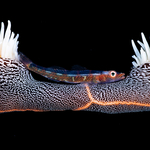The decades of expertise behind Mares and rEvo rebreathers have combined to create a unique semi-closed rebreather (SCR) like no other….. https://www.mares.com/en-GB/sports/diving/horizon-photo&video/
Priding itself on innovation and safety the Mares Horizon SCR has a very unique scrubber system.
There are two key components of any scrubber system used in a SCR:
Scrubber material
Scrubber canister
Scrubber Material Function
The scrubber system used in an SCR has one function: to remove carbon dioxide (CO2) from the exhaled gas as quickly and with as little friction as possible. To achieve this, we make the distance the gas travels through the SCR scrubber system as short as possible. If the distance is too short, the contact time of the gas with the chemicals in the scrubber material is too brief. The CO2 will skip the material, which negates the benefits of the scrubber material. If the scrubber system is too long, the work of breathing becomes difficult and limits performance.
Scrubber Material Composition
The type and size of scrubber granules affects the work of breathing, the density of the gas, and the scrubber design. Staying well within the manufacturer’s prescribed scrubber time is critical. If the scrubber material has a large granule size, there is less surface area that contacts the carbon dioxide. A smaller granule size means a better active surface area but a higher breathing resistance. This is why we should use only manufacturer tested and approved products as a scrubber absorbent.
Scrubber Canister Designs
The gas plenum, or scrubber canister, is the housing of the scrubber material. This area should be warm, dry, and shelter the scrubber from impact. Most SCRs have their sensors and electronics located here.
Axial Scrubber System
The most common design of scrubber canister is the axial canister. This is a tube filled with granules made of a variety of components, commonly calcium hydroxide, water, and a small amount of caustic sodium hydroxide. The gas enters from the bottom of the canister and exits from the top so the scrubber material saturates from the bottom upwards. This distance is the furthest the gas can travel. As long as we keep a good reserve distance from the end of the tunnel, it is a safe system design that makes it less expensive and easier to prepare. The Mares Horizon uses an axial scrubber system.
Radial Scrubber System
In a scrubber system with a radial design, the gas enters from the side through a mesh or sieve. The gas then travels through the scrubber material until it reaches the center tunnel, where then it travels up. The surface area of the scrubber material is much larger, making the work of breathing easier, and it more effectively uses of all the scrubber material.
The Mares Horizon Dual Scrubber System
The Mares Horizon uses a unique dual scrubber canister configuration. Two canisters are mounted in an axial, serial configuration to improve streamlining and reduce the size of the unit. Each canister holds approximately one kilogram of scrubber material, also called “absorbent” or “sorb”. The two canisters are connected by a channel in the main case cover. The scrubber material that is closest to the point where gas flows into the scrubber canister is saturated first. The scrubber material in the far end of the scrubber canister should never become saturated because you will always change the scrubber material before it becomes completely saturated. The scrubber system used in the Mares Horizon is only effective if the correct procedure for changing scrubber material is used. Each scrubber canister is labelled to avoid mistakes.
Cycling Scrubber Canisters
Start with two canisters that are filed with fresh scrubber material:
Place “Canister 1” in the upper cavity (on the exhale counterlung).
Place “Canister 2” in the lower cavity (on the inhale counterlung).
After a period of use, Canister 1 is removed and emptied.
Canister 2 is removed from the lower cavity and placed in the upper cavity.
Canister 1 is refilled with fresh scrubber material and is placed in the lower cavity.
The cycle is repeated as necessary, with the canister from the bottom cavity replacing the canister in the upper cavity.
During the refill and replacement phase of the cycle, half of the total scrubber material is discarded. Since you always discard the half from the top canister, where CO2 saturation begins, the most-saturated scrubber material, or the material closest to the incoming gas, is always discarded first. By placing the unused scrubber material in the lower cavity, we ensure that any CO2 that is not absorbed by the older material is captured by the fresh material in the second canister. When compared to a single-canister system that completely replaces the scrubber material each time, this process increases the use of the scrubber material by about 50% without affecting safety.
The TOP Marker
Confusing which scrubber canister contains fresh scrubber material is a potentially dangerous mistake. To help avoid this error, the Mares Horizon includes a “TOP marker”. This marker is a small indicator that is installed on the top of the canister in the upper cavity over the exhale lung.
To prevent any mistakes, you should follow this procedure exactly:
Take the top canister with the TOP marker out of the upper cavity.
Unscrew the TOP marker and immediately empty that canister of the used scrubber material.
Re-screw the TOP marker onto the canister that still contains scrubber material and put that canister into the top cavity.
Refill the empty canister and put it in the lower cavity.
Record in the log that the bottom canister was refilled with fresh scrubber material.
To find out more about the Mares Horizon SCR and the SSI SCR Diving program head to https://www.divessi.com/en/advanced-training/extended-range/scr-diving
The post The Mares Horizon Scrubber System appeared first on Dive SSI.
Read MoreExtended Range, horizon, Mares, scrubber, scrubber systemDive SSI


